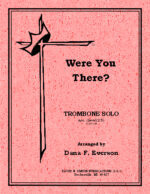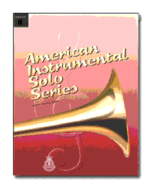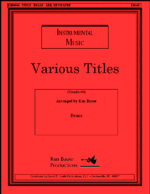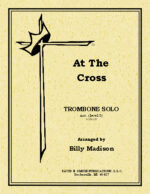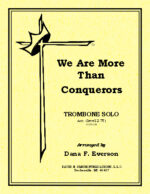-
Classic Praise- Trombone/BHBC/Bassoon
$12.99With CD accompanimentt- includes: Fairest Lord Jesus, Holy Holy Holy, All Glory Laud and Honor, All Hail The Power, When Morning Guilds The Skies and more…
-
Were You There?
$4.00This solo piece opens with a sense of reverence presenting the melody in a gently modified fashion. The middle section gains intensity rhythmically with a rhapsodic form of theme variations. It continues to elevate only to relax into final peace.
-
Instruments Of Joy- Trombone- Book and CD
$24.95Includes piano accompaniment, removeable solo insert and CD…
-
Concert and Contest Solo Collection Trombone (Piano Acc. Book)
$6.95Also available: CD contains split tracks for full performance and paino accompaniment only. Tempo adjustment software included. AND Solo book.
-
Concert and Contest Solo Collection Trombone (Solo Book only)
$4.95Also available: CD which contains split tracks for full performance and paino accompaniment only. Tempo adjustment software included.And, Piano accompaniment book.
-
Concert and Contest Solo Collection Trombone (CD only)
$9.95CD contains split tracks for full performance and paino accompaniment only. Tempo adjustment software included.
-
Tons Of Tunes For Church
$12.95With CD accompaniment, 32 familiar melodies like: Abide With Me, Now We Thank We All Our God, Swing Low, Onward Christians Soldiers and more
-
Solos & Duets for Bass Clef Instruments & Acc.
$26.95Twelve Solos & Duets for Bass Clef Instruments & Acc.
-
Still, Still, Still
$6.95This sweet Austrian Christmas carol’s melody moves from trombone to piano and is then interwoven with other gentle reminders of the season such as a short statement of Silent Night and a motive of the “clock” melody.
Flute Solo with Piano Accompaniment -
Christmas Instrumental Solos: Carols & Traditional Classics
$10.99Solos w/CD acc: single titles; three medleys,, two suites
-
Instrumental Praise & Worship (BC edition)
$12.95Solos or duets (all editions work together). Includes: As The Deer, Give Thanks, He Is Exalted, How Majestic Is Your Name, Our God Reigns, We Have Come Into His House, and more…
-
At The Cross
$4.50This is a trombone solo with piano which presents the opening melody in a straight forward manner. The middle sections use various cleverly designed counter melodies in the solo part. The final section establishes the original melody.
-
We Are More Than Conquerors
$4.50This solo with piano is presented in a militaristic venue. The interlude section displays fanfare motifs and then moves back to the opening style. The piece ends in a bold statement of faith-musically.
-
What Child Is This?
$7.95A Christmas carol crafted gracefully with emotion employing light and delicate textures that hint at the medieval yet are augmented with rich and poignant harmonies and a melodic development that promotes thoughtful, meditative expressions. Hn & Pn.
-
Two For Easter (BC Instruments- trombone, euph. etc.)
$7.95Unacc. Duets of Easter, used interchangeably with other keyed instruments in the “Two For Easter” series
-


